新版~上海~牛津英语~2B~知识点教学内容
上海牛津英语2B重点词汇和句型语法资料讲解
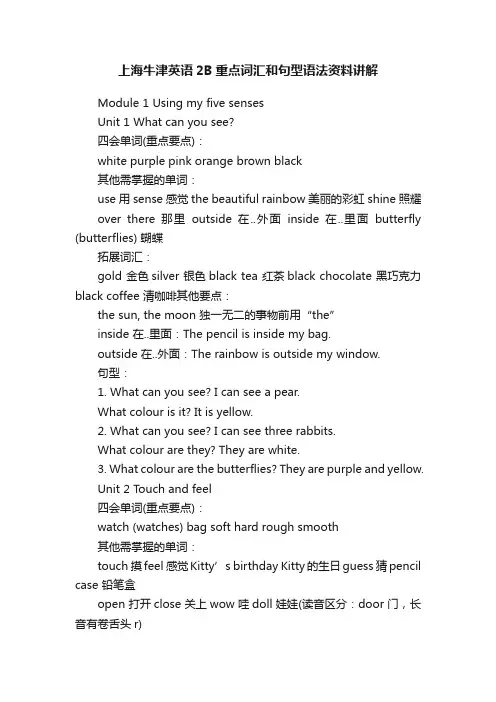
上海牛津英语2B重点词汇和句型语法资料讲解Module 1 Using my five sensesUnit 1 What can you see?四会单词(重点要点):white purple pink orange brown black其他需掌握的单词:use 用sense 感觉the beautiful rainbow 美丽的彩虹shine 照耀over there 那里outside 在..外面inside 在..里面butterfly (butterflies) 蝴蝶拓展词汇:gold 金色silver 银色black tea 红茶black chocolate 黑巧克力black coffee 清咖啡其他要点:the sun, the moon 独一无二的事物前用“the”inside 在..里面:The pencil is inside my bag.outside 在..外面:The rainbow is outside my window.句型:1. What can you see? I can see a pear.What colour is it? It is yellow.2. What can you see? I can see three rabbits.What colour are they? They are white.3. What colour are the butterflies? They are purple and yellow.Unit 2 Touch and feel四会单词(重点要点):watch (watches) bag soft hard rough smooth其他需掌握的单词:touch 摸feel 感觉Kitty’s birthday Kitty的生日guess 猜pencil case 铅笔盒open 打开close 关上wow 哇doll 娃娃(读音区分:door 门,长音有卷舌头r)拓展词汇:watch TV 看电视schoolbag 书包handbag 手袋手感的词:hot-cold long-short big-small soft-hard rough-smooth句型:1. Touch this bag. Is it smooth? Yes, it is.Touch this bag. Is it smooth? No. It is rough.2. Is it hard? Yes, it is hard.Is it hard? No, it isn’t hard.Is it soft? Yes, it is.Is it soft? No, it isn’t.3. Happy Birthday, Kitty! Thank you.4. It’s for you. It’s for me. It’s for her. It’s for him.5. Do you like it? Yes, I do. No, I don’t.Do you like it? Yes, I like it. No, I don’t like it.其他:Pp /p/ pig, please, skip 但注意“ph”中“p”发音就不是/p/了, “ph”是一个整体,发音/f/:elephant, photoUnit 3 What can you hear?四会单词(重点要点):train bus (buses) car van bicycle (=bike) ship其他需掌握的单词:listen 听一听hear 听见enjoy 欣赏story 故事beside 在..旁边up 上面down 下面the bus stop 公交车站wait for the bus 等公交车拓展词汇:take a bus 坐公交车take a No. 116 bus 坐116路公交车taxi (taxis) 出租车plane 飞机metro 地铁on the road 在马路上Shuichan Road 水产路Yongqing Road 永清路(Rd.=Road)其他要点:bus-boop train-choo van-beep bicycle-ding dog-woof cat-meow(miaow) bird-tweet duck-quackbeside 在..旁边inside 在..里面outside 在..外面in 在..里面out 在..外面on在..上面under在..下面beside the window, inside the classroom, outside the restaurant, in the box, go out, out of the box,on the table, under the chair句型:1. Listen! What can you hear? I can hear a train. It goes “Choo…Choo…”(bus-boop train-choo van-beep bicycle-ding)2. What can Ming hear? Ming can hear a dog.Can Ming hear a car? Yes, Ming can hear a car.Can Ming hear a ship? Yes, Ming can hear a ship.Can Ming hear a bird? No, Ming can’t hear a bird.3. Here it comes! 它来了!其他:Tt /t/ tiger, taste, too 但注意“th”中“t”发音就不是/t/了, “th”是一个整体:this, that ; three,tooth, teeth“tr”中“t”发音也不是/t/了, “tr”是一个整体:tree, trash, trick Dd/d/ dog, desk, red 但注意“dr”中“d”发音不是/d/了,“dr”是一个整体:dress, dream, dropModule 2 My favourite thingsUnit 1 Things I like doing四会单词(重点要点):run skate hop skip ride a bicycle like其他需掌握的单词:favourite 最喜欢的thing 东西too 也together 一起sing with me 与我一起唱(sing 可换dance, write…)拓展词汇:ski 滑雪play football踢足球play basketball打篮球play volleyball 打排球play tennis 打网球play table tennis / ping pong打乒乓球play yo-yo 玩溜溜球play Kongfu打功夫do Yoga做瑜伽其他要点:关于+ing:1) 直接加ing: doing, seeing, skiing, eating, flying, drinking, singing, jumping, drawing, reading2) 去e: riding, writing, skating, dancing, coming, making, taking, shining, using3) 结尾双写: running, hopping, skipping, swimming, sitting, cutting, having, making,taking句型:1. Do you like running? Yes, I like running. No, I don’t like running. I like hopping. Do you like running? Yes, I do. No, I don’t.I like hopping.2. I like flying.I like flying, too.Let’s go flying together. (flying还可换成eating, dancing, sing ing……)其他:Gg发音/g/ girl, frog注意g还有发音/d?/ orange, huge 做辨音题目时要读一读单词来判断哦Unit 2 My favourite food四会单词(重点要点):salad chicken carrot banana fish(“鱼肉”不可数,“鱼”单复数同形,指鱼的种类时可数fishes)其他需掌握的单词:food 食物soup 汤meat 肉noodles 面条rice 米饭pizza 披萨hamburger 汉堡包yummy 鲜美的biscuit 饼干cookie 曲奇饼cake 蛋糕拓展词汇:make salad 做色拉fruit salad 水果色拉vegetable salad 蔬菜色拉eat some fish 吃一些鱼肉句型:1. What do you like eating? I like eating salad.What do you like eating? I like eating bananas. (注意用复数)2. What do you like doing? I like eating. I like eating carrots.What do you like doing? I like singing. I like singing Do-Re-Mi.3. What do you like eating?I like eating cakes.I like eating cakes, too.4. I like chicken. I like carrots. I like eating chicken and carrots.其他:Hh发音/h/ hand, hen, hot “th”整体:this, that; three, tooth, teeth“ch”整体:chair, chick, children“ph”整体:elephant, photo, telephone“sh”整体:sheep, shine, show“wh”整体:what, where, when, whichUnit 3 Animals I like四会单词(重点要点):animal giraffe (giraffes) snake elephant zebra (zebras)其他需掌握的单词:tail 尾巴wolf (wolves) 狼fox (foxes) 狐狸hippo (hippos) 河马mouse (mice) 老鼠wild animals 野生动物farm animals 牧场动物insect 昆虫in the toy shop 在玩具店里拓展词汇:leaf (leaves) 叶子a long neck 一个长脖子a long body 一个长身体a long nose 一个长鼻子fan 扇子yo-yo 溜溜球skateboard 滑板PSP, Gameboy 游戏机名称句型:1. What are they? They are zebras.2. What do they like eating? They like eating grass.3. Do you like zebras? Yes, I do. No, I don’t.4. Look at the snake. It looks like a rope.Look at the snakes. They look like ropes.I like the elephant. The ears look like fans. The eyes look like balls. The teeth look like knives.5. May I have one? O.K.May I have a toy pig? O.K.6. I like it very much.(单数,我很喜欢它) I like them very much.(复数,我很喜欢它们)Module 3 Things around usUnit 1 The four seasons四会单词(重点要点):spring 春天summer 夏天autumn 秋天winter 冬天warm 温暖的hot 热的cool 凉爽的cold 冷的其他需掌握的单词:season 季节outside 在外面inside 在里面(inside the room) very 非常的in spring 在春天in summer 在夏天in autumn 在秋天in winter在冬天eat fruit 吃水果make a snowman (复数snowmen) 做一个雪人句型:1. Spring, spring, nice and warm. Spring, spring, I like spring.Summer, summer, sunny and hot. Summer, summer, I like summer.Autumn, autumn, windy and cool. Autumn, autumn, I like autumn.Winter, winter, cloudy and cold. Winter, winter, I like winter.2. I like riding my bicycle in the park.I like swimming in the water.I like flying a kite in the park.I like skating on the ice.。
牛津英语上海版2B教案汇总
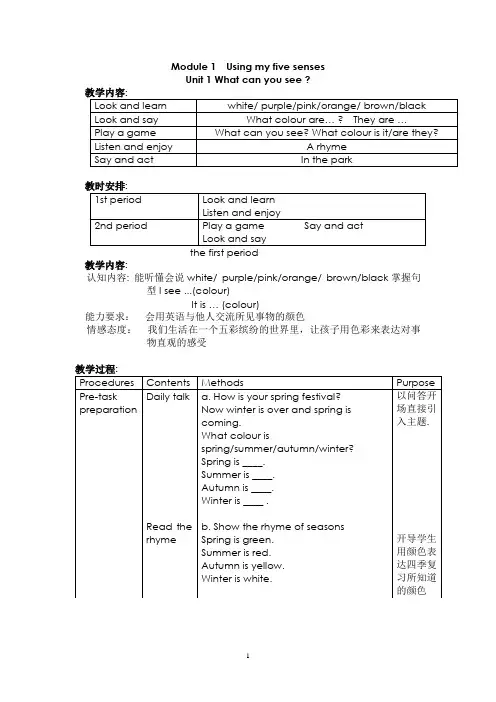
Module 1 Using my five sensesUnit 1 What can you see ?教学内容:认知内容: 能听懂会说white/ purple/pink/orange/ brown/black掌握句型I see ...(colour)It is … (colour)能力要求:会用英语与他人交流所见事物的颜色情感态度:我们生活在一个五彩缤纷的世界里,让孩子用色彩来表达对事物直观的感受the second period教学内容:认知内容: 1. 能听懂会说句型What colour is it /are they?It is /They are …能力要求: 1. 能在日常生活中用以上的句型进行对话情感态度:鼓励孩子用所学的句型在公共场合与他人进行交流Module 1 Using my five sensesUnit 2 Touch and feelTeaching aims:Knowledge:1.Learning new words: watch, bag, soft, hard, rough, smooth2.Learning sentence patterns: Is it…? Yes, it. /No. it‟s …Skills:1.Understanding the key words in context.ing the new words and sentence patterns to communicate withothers.Feelings:学生在游戏和表演中学习新的知识, 并能通过有趣的儿歌来巩固新学的词汇及句型。
the second periodTeaching aims:Knowledge:1. Learning the sentence pattern: Is it…? Yes, it. /No. it‟s …2. Using the sentence pattern to express.3. Learning the sounds of the letters: p, b.Language skills:1. Identifying the key words by listening to the pronunciation.2. Understanding the key patterns.3. Identifying the sounds by listening to the pronunciation.Feelings:学生在游戏和表演中学习新的知识, 并通过游戏和表演来巩固新知识,创设良好的活动氛围, 让学生带着愉快的心情去迎接新挑战.Module 1 Using my five sensesUnit 3 Can you hear a train?教学内容:The first period教学内容:认知内容: 1.单词:train, bus, car, van, bicycle, ship。
牛津英语上海版2B教案
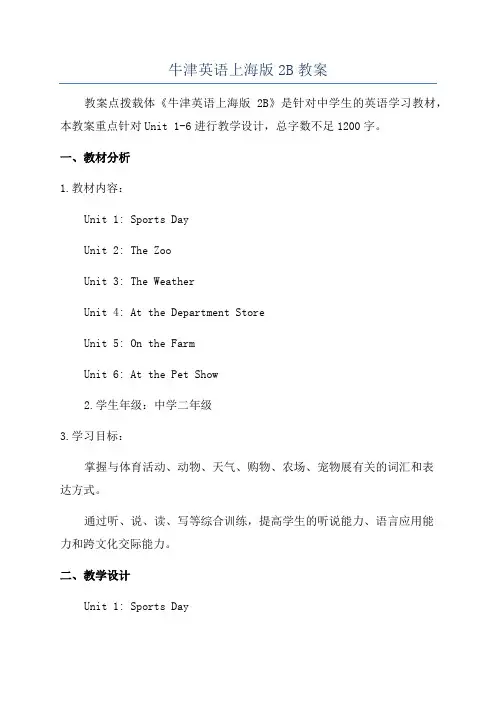
牛津英语上海版2B教案教案点拨载体《牛津英语上海版2B》是针对中学生的英语学习教材,本教案重点针对Unit 1-6进行教学设计,总字数不足1200字。
一、教材分析1.教材内容:Unit 1: Sports DayUnit 2: The ZooUnit 3: The WeatherUnit 4: At the Department StoreUnit 5: On the FarmUnit 6: At the Pet Show2.学生年级:中学二年级3.学习目标:掌握与体育活动、动物、天气、购物、农场、宠物展有关的词汇和表达方式。
通过听、说、读、写等综合训练,提高学生的听说能力、语言应用能力和跨文化交际能力。
二、教学设计Unit 1: Sports Day1. Warm-up Activity: Have a class discussion about favorite sports, ask students to share their opinions and reasons.2. Vocabulary: Introduce new vocabulary related to sports, such as running, jumping, swimming, etc. Use flashcards and real objects to help students understand and memorize the words.3. Listening: Play a recording of a sports event, ask students to listen and answer questions about the participants and their performance. Have a class discussion about the sports event.4. Speaking: Organize a mini sports day in the classroom. Divide the class into groups and assign different sports to each group. Students will take turns performing their chosen sports and describing their actions in English.6. Writing: Ask students to write a paragraph about their favorite sports and why they like it. Provide sentence starters and vocabulary to support their writing.Unit 2: The Zoo1. Warm-up Activity: Show students pictures of different animals, ask them to identify the animals and describe their characteristics.2. Vocabulary: Introduce new vocabulary related to animals, such as lion, elephant, giraffe, etc. Use flashcards and real pictures to help students understand and remember the words.3. Listening: Play a recording about a visit to the zoo, ask students to listen and answer questions about the animals seenat the zoo. Discuss the experience as a class.4. Speaking: Organize a group presentation about different animals. Each group will research and present information about an assigned animal, including its physical characteristics, habitat, and behavior.6. Writing: Ask students to write a paragraph about their favorite animal and describe its appearance and characteristics. Provide sentence starters and vocabulary to support their writing.Unit 3: The Weather1. Warm-up Activity: Review previous knowledge about different types of weather. Ask students to share their favorite weather and reasons.2. Vocabulary: Introduce new vocabulary related to weather, such as sunny, rainy, windy, etc. Use flashcards and pictures to help students understand and remember the words.3. Listening: Play a weather report recording, ask students to listen and identify the weather conditions mentioned. Discuss the weather conditions and their impact on activities.4. Speaking: Organize a weather forecast presentation. Each group will research and present a weather forecast for a chosencity, including the current weather conditions and predictionsfor the next few days.6. Writing: Ask students to write a short weather report fora chosen city. Provide sentence starters and vocabulary to support their writing.Unit 4: At the Department Store2. Vocabulary: Introduce new vocabulary related to department store items, such as clothes, shoes, bags, etc. Use flashcards and real objects to help students understand and remember the words.3. Listening: Play a conversation between a customer and a shop assistant in a department store, ask students to listen and answer questions about the customer's needs and the shopassistant's suggestions. Discuss the conversation as a class.4. Speaking: Organize a role play activity where studentsact as customers and shop assistants. They will take turns practicing conversations in a department store setting, focusing on making inquiries and providing suggestions.6. Writing: Ask students to write a short letter to a friend, describing a shopping experience in a department store. Provide sentence starters and vocabulary to support their writing.Unit 5: On the Farm1. Warm-up Activity: Show pictures of different farm animals, ask students to identify the animals and describe their appearances and behaviors.2. Vocabulary: Introduce new vocabulary related to farm animals, such as cow, sheep, chicken, etc. Use flashcards, videos, and real objects to help students understand and remember the words.3. Listening: Play an audio recording about life on a farm, ask students to listen and answer questions about the daily activities and responsibilities of farmers. Discuss therecording as a class.4. Speaking: Organize a class discussion about farming andits importance. Ask students to share their thoughts on why farming is important and the challenges faced by farmers.6. Writing: Ask students to write a diary entry about avisit to a farm. Provide sentence starters and vocabulary to support their writing.Unit 6: At the Pet Show1. Warm-up Activity: Show pictures of different pets, ask students to identify the pets and share their experiences with pets.2. Vocabulary: Introduce new vocabulary related to pets,such as cat, dog, rabbit, etc. Use flashcards and real picturesto help students understand and remember the words.3. Listening: Play a conversation between pet owners at apet show, ask students to listen and answer questions about the pets being shown and their unique features. Discuss the conversation as a class.4. Speaking: Organize a pet show in the classroom. Each student will bring a toy pet and present it to the class, describing its special features and characteristics.6. Writing: Ask students to write a short paragraph about their ideal pet and why they would choose it. Provide sentence starters and vocabulary to support their writing.以上是《牛津英语上海版2B》教学设计的主要内容,根据课程特点和教学目标,选择了适合学生的各种教学活动和评估手段。
上海版牛津小学英语2b教案全册 2B教案U5_2
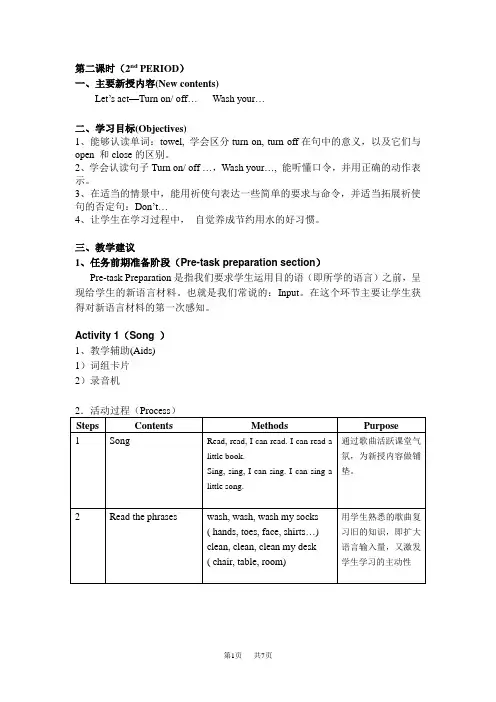
第二课时(2nd PERIOD)一、主要新授内容(New contents)Let’s act—Turn on/ off…Wash your…二、学习目标(Objectives)1、能够认读单词:towel, 学会区分turn on, turn off在句中的意义,以及它们与open 和close的区别。
2、学会认读句子Turn on/ off …,Wash your…, 能听懂口令,并用正确的动作表示。
3、在适当的情景中,能用祈使句表达一些简单的要求与命令,并适当拓展祈使句的否定句:Don’t…4、让学生在学习过程中,自觉养成节约用水的好习惯。
三、教学建议1、任务前期准备阶段(Pre-task preparation section)Pre-task Preparation是指我们要求学生运用目的语(即所学的语言)之前,呈现给学生的新语言材料。
也就是我们常说的:Input。
在这个环节主要让学生获得对新语言材料的第一次感知。
Activity 1(Song )1、教学辅助(Aids)1)词组卡片2)录音机Activity 2(Rhyme )1、教学辅助(Aids)1) 录音机Activity 3(Read a chant )1、教学辅助(Aids)1)录音机2)单词卡片2、任务中期实施阶段(While-task procedure section)While-task Procedure,这是指语言技能的习得过程。
其中分为机械性操练和意义性操练两部分。
机械性操练可以让学生准确地模仿、复说新授的语言,让他们经过从模仿到识记的过程,使新知识由感知、理解、模仿直到储存。
由于本教时新授内容有词汇也有句子而且都在两个以上,在这个教学阶段也可以设计新授知识的二次或多次导入,并根据语言训练的需要设计相应的机械性操练和意义性操练。
在这种情况下,建议每项Activity形式尽可能不同,时间不要长,一个活动紧接着一个活动,容易抓住学生的注意力,维持学习兴趣。
沪教牛津英语2b教案
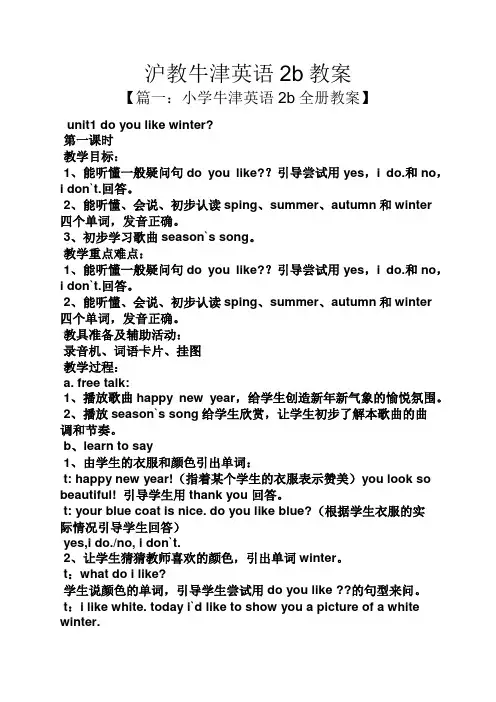
沪教牛津英语2b教案【篇一:小学牛津英语2b全册教案】unit1 do you like winter?第一课时教学目标:1、能听懂一般疑问句do you like??引导尝试用yes,i do.和no,i don`t.回答。
2、能听懂、会说、初步认读sping、summer、autumn和winter四个单词,发音正确。
3、初步学习歌曲season`s song。
教学重点难点:1、能听懂一般疑问句do you like??引导尝试用yes,i do.和no,i don`t.回答。
2、能听懂、会说、初步认读sping、summer、autumn和winter四个单词,发音正确。
教具准备及辅助活动:录音机、词语卡片、挂图教学过程:a. free talk:1、播放歌曲happy new year,给学生创造新年新气象的愉悦氛围。
2、播放season`s song给学生欣赏,让学生初步了解本歌曲的曲调和节奏。
b、learn to say1、由学生的衣服和颜色引出单词:t: happy new year!(指着某个学生的衣服表示赞美)you look so beautiful! 引导学生用thank you 回答。
t: your blue coat is nice. do you like blue?(根据学生衣服的实际情况引导学生回答)yes,i do./no, i don`t.2、让学生猜猜教师喜欢的颜色,引出单词winter。
t:what do i like?学生说颜色的单词,引导学生尝试用do you like ??的句型来问。
t:i like white. today i`d like to show you a picture of a white winter.教师出示冬天的图片,引出winter,组织学生听单词录音,朗读单词。
3、以相同的方法学习单词sping、summer、autumn。
上海版牛津小学英语2b教案全册 2B教案U9_3
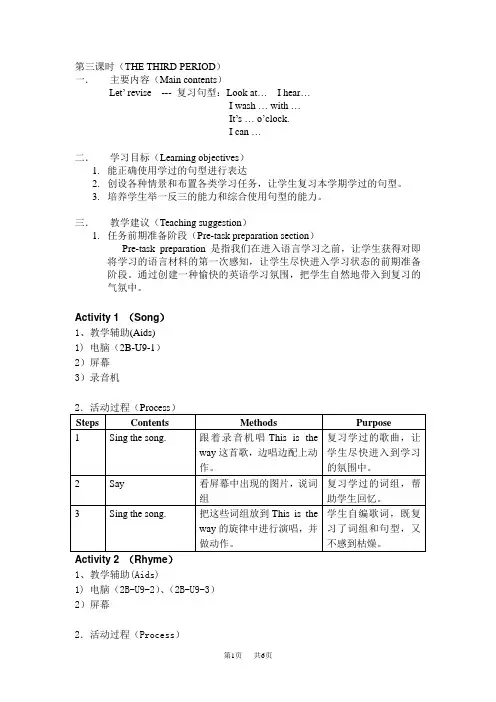
第三课时(THE THIRD PERIOD)一.主要内容(Main contents)Let’ revise --- 复习句型:Look at…I hear…I wash … with …It’s … o’clock.I can …二.学习目标(Learning objectives)1.能正确使用学过的句型进行表达2.创设各种情景和布置各类学习任务,让学生复习本学期学过的句型。
3.培养学生举一反三的能力和综合使用句型的能力。
三.教学建议(Teaching suggestion)1.任务前期准备阶段(Pre-task preparation section)Pre-task preparation 是指我们在进入语言学习之前,让学生获得对即将学习的语言材料的第一次感知,让学生尽快进入学习状态的前期准备阶段。
通过创建一种愉快的英语学习氛围,把学生自然地带入到复习的气氛中。
Activity 1 (Song)1、教学辅助(Aids)1) 电脑(2B-U9-1)2)屏幕3)录音机Activity 2 (Rhyme)1、教学辅助(Aids)1)电脑(2B-U9-2)、(2B-U9-3)2)屏幕2.活动过程(Process)2、任务中期实施阶段(While-task procedure section )While-task Procedure ,这是指语言技能的习得过程。
其中分为机械性操练和意义性操练两部分。
机械性操练:让学生准确地模仿、复说要学习的知识,从模仿到识记,使新知识由感知、理解、模仿直到储存。
Activity 1(Discuss ) 1、教学辅助(Aids) 1) 电脑(2B-U9-4) 2)屏幕Activity 2 (What time is it?) 1、教学辅助(Aids) 1)电脑(2B-U9-5) 2)屏幕完成比较扎实的机械性操练后,就进入了意义性操练阶段。
意义性操练是介于机械性操练和交际性操练之间,起着承上启下的作用,把语言形式的操练转向语言内容的操练,使学生的认知逐步从知识外部特征转向知识内在的联系。
上海牛津教材2B课件
复习语法和句型
复习时态
对本单元学习的时态进行总结,如现在进行时、一般现在时等。
复习句型
归纳本单元学习的重点句型,如疑问句、否定句等。
复习课文内容和练习
回顾课文
重新阅读本单元的课文,加深对课文内容的理解。
完成练习
完成本单元的练习题,巩固所学知识,提高运用能力。
05
单元五:扩展学习
相关文化背景知识
写作练习
写作练习1
写简单的句子。让学生根据给定的提示或图片,写出简单的句子。
写作练习2
写一段话。让学生根据给定的主题或提示,写出一段连贯的话。
04
单元四:总结和复习
复习重点词汇和短语
总结重点词汇
将本单元学到的重点词汇进行归纳, 如描述动物、食物、颜色等词汇。
复习短语
回顾本单元学到的常用短语,如“喜 欢吃”、“想要做”等。
总结词
通过相关语言技能提升的训练,可以帮助学 生更好地掌握英语语言技能,提高英语表达 能力。
详细描述
在单元五的扩展学习中,可以设计一些相关 语言技能提升的训练,例如阅读理解、写作 练习、听力训练等。这些训练可以帮助学生 更好地掌握英语语言技能,提高他们的英语 表达能力,同时也可以培养他们的语言运用 能力和自主学习能力。
总结词
了解单元主题相关的文化背景知识,有助于学生更好地理解课文内容,提高跨文化交际 能力。
详细描述
在单元五的扩展学习中,可以介绍一些与主题相关的文化背景知识,例如西方国家的节 日、风俗习惯、历史背景等。这些知识可以帮助学生更好地理解课文中涉及的文化元素,
提高他们的跨文化交际能力。
相关学科知识拓展
总结词
教材特点
本教材注重实际应用,通过丰富的 插图和游戏等形式激发学生学习兴 趣,同时注重语音和语感的培养。
上海版牛津英语2B课程教案
Period 5 Let’s enjoy.Contents: story: I’ve got a cow. It goes ‘moo, moo’.Aims: ⒈Using formulaic expressions to indicate possessions. e.g. I’ve got a cow.⒉Using formulaic expressions to indicate what noise animalsmake. e.g. It goes ‘moo, moo’.Main points: Using formulaic expressions to indicate possessions and what noise animals make.Difficulties: Pronounce correctly words in connected speech by linking together and using appropriate stress.Aids: Student’s Book, tape, a toy animal2B Unit 1 Farm AnimalsPeriod 1 Let’s learnContents: 1.Word: hen, chick, duck, cow, pig2.Letter: N n nose, O o orangeAim: ing nouns to identify common farm animals.e.g. hen, chick2.Learn the above names and sounds of the letters ‘N n, O o’.3.Knowning about the farm animals and say something aboutthe animals you like.Main points: Using nouns to identify common farm animals. Difficulties: Pronounce words properly.Aids: 1.T: picture cards, words cards, tape, Student’s Book and Wordbook.P: picture cards (students prepared beforehand )Period 2 Let’s talkContents: What do you see? I see┄What do you hear? I hear┄Aims: 1. Asking ‘wh’questions to find out specific information about a farm.e.g. What do you see /hear?2.Using the simple present tense. e.g. I see/hear a duck.Main Points: Asking and answering the ‘wh’questions. Difficulties: Using the models to communicate with other learners. Aids: the wallchart for page 3, six picture cards and six word cards ,tape , Student’s Book and WorkbookProcedures:ⅠPre-task preparation⒈Show six toy farm animals or pictures of them.Ask students to name in English.⒉Show sixword cards. Ask students to read them.Period 3 Let’s actContents: Draw the cow on the paper. Draw the duck on the ground. Aims: ⒈Using imperatives to give simple instructions. e.g. Draw the cow on the paper.⒉Locating specific information in response to simple instructions.⒊Using modeled phrases to communicate with other learners. Main points: Using imperatives to give simple instructions. Difficulties: Using modeled phrases to communicate with other learners. Aids: plain sheets of paper, toy animals, animal picture cards, tape, Workbook, Student’s BookPeriod 4. Let’s play.Contents: Listen, tick and say: I hear a…Aims: ⒈Using the simple present tense to indicate what you hear. e.g. I hear a sheep.2. Using nouns to refer to farm animals. e.g. cowMain points: Using the simple present tense to indicate what you hear. Difficulties: Recognizing key words of the animals.Aids: Student’s Book and Workbook, tape, word and picture cards2B Unit2 In the circus Period1 Let’s act Teaching aims:1)Locate specific information in response to simple instructions.2)Use imperatives to give simple instructions.3)Learn the sentences: Come here. Go there. Come back . Education aims:Foster the thought of loving animals.Difficult points:Using imperatives to give simple instructions.Materials:Cassette 2B and cassette player.Animal masksTeaching essay2B Unit2 In the circus Period2 Let’s learn Teaching aims:1)Learn the words: horse, bear, elephant, tiger, monkey, panda.2) Pronounce words properly.Education aims:Foster the thought of loving animals.Difficult points:Using nouns to identify animals.e. g. bear, elephantMaterials:Cassette 2B and a cassette player.Wookbook 2B page 6.Animal masks.Teaching essay2B Unit2 In the circus Period3 Let’s talk Teaching aims:1)Learn the sentences: Look at the…It’s…and…2) Use imperatives to draw attention to something.3 ) Use adjectives to describe animals.Education aims:Foster the thought of loving animals.Difficult points:Use imperatives to draw attention to the animals and describe them.Materials:Cassette 2B and a cassette playerWord and picture cards (animals)Wallchart 2BAnimalsTeaching essay2B Unit 2 Period 4 In the circus Letters Basic aim: ing nouns to identify things.. .. e.g. pencil, quilt.2. Learning the letters: Pp , Qq.Difficult point: Writing the lettersTeaching essay2B Unit 2 Period 5 Let’s play Guess Who’s my friend? Basic aim:ing connectives to link two adjectives.e.g. She is little and white.2.Asking “Wh-’’questions to find out specific information abouta person.e.g. Who is she?Developing aims:1.Learn other words. e.g. tail,short.2.Make a riddle.Materials: cassette,player,toys,masks.Teaching procedure:Teaching essayUnit 2 Let’s enjoyPeriod 6 Song Basic aim:ing imperatives to draw attention to somethinge. g. Look at the bear.ing adjectives to describe animalse. g. It’s big and brown.Developing aims:1.Rhyme2.Like animals, like nature.Materials:Cassette, player, pictures, masks.Teaching procedure:Teaching essayUNIT 3 Let’s learnPeriod 1Teaching aims:1.Basic aims: a. To learn the letters: Rr Ss.b. To learn the words: rubber, sweet.c. Add a new word: chocolate.2.Developing aims: using the words to make some sentences, make some dialogues or some rhymes.Main points: To learn the letters and the words.Difficult points: The pronunciation of ‘Rr’.Materials: letter cards, picture cards, cassette.Teaching essayUNIT 3 Let’s learnPeriod 2Teaching aims:1.Basic aims:To learn the seven words: window, door, bed, room, sofa, table, lamp.2.Developing aims: Using the words to describe a room.Main points: To learn the words.Difficult points: Using some English to describe the words. Materials: cassette, picture cards, a big picture of a room.Teaching essayUNIT 3 Let’s actPeriod 3Te aching aims:1.Basic aims: Using imperative to give simple instructions: Close the window, please.2. Developing aims: Using imperative in the correct situation. Main points and difficult points:Use modelled phrases to communicate with other learners. Materials: cassette, picture cards, the picture of ‘my room’Teaching essay2B UNIT 3 Let’s talkPeriod 4Teaching aims:1.Basic aims:(1)Using the simple present tense to indicate facts. E.g. This is myroom.(2)Using introductory ‘There’to express facts. E.g. There is / are…in my room.2. Developing aims: T o describe one place using ‘There is/are…’. Education aims: Let the students to love their homes.Main points and difficult points:Using ‘This is …’‘There is/are …’to express facts. Materials: cassette, the tape of listening( 2parts),the tape of the sounds(the admire and bewail sounds),some pictures, cards. etc.。
上海版牛津英语2B教案.doc
Unit 7 Hot SummerPeriod 1 Education Aims:Don't leave rubbish on the beach・Teaching Aims:1. Basic aims.A: To learn the words: beach, shellsB: To learn the drills.e. g. Lefs go to the beach.2. Developing Aims:A: Say another sentences・e.g .Let's pick up rubbish ・ B: Free talk.Materials:Cassette player, pictures, objects Teaching Procedure:2. Learn: go to the beachT: (show a picture of a slide) **, go to the slide.T:( Point to the beach) We can say:P: Go to the beach.Ask the pupils to say: Go to the beach.3. Learn : Lefs go to the beach.(show a picture)T: Today is a holiday. Its very hot. Lefs go to the beach. OK? P:OK>Say and act. T-P P-P4. Learn: Lefs play on the beach.T: Here is the beach. Lefs play on the beach.Say and act: Lefs play on the beach. T-P P-T5. Learn: shellsT: (Put some shells on the floor) Oh, some shells, shells. Ask the pupils to read.T: Lefs pick up shells. (Say and act.)Work in pairs using another objects・ e.g. Lefs pick up pencils ・T: (Throw the rubbish on the floor)Don5t leave rubbish・ Lefs pick up rubbish・6. Read after the tape.7. Sing a song :《Down by the bus stop》由单词到词组,分散难点的同时,逐步增加输入量。
上海版牛津英语2B各单元教学内容分析
上海版牛津英语2B各单元教学内容分析2B Unit 1 Farm animals【单元分析(UNIT ANALYSIS)】一.教材地位(UNIT POSITION)1.从第一、二单元“动物”的主题来看,本单元教材内容是着重围绕“农场上的动物”这个课题展开。
2.在一年级,学生已会用口语表达I’ve got…以及I see a …句型,在此基础上,本单元巩固了这些句型,并通过有关动物词汇的累积和问答句的使用丰富了句子表述的语意。
3.在本册教材中,学生将继续识认书写大小写字母。
4.本单元学生将学习农场上常见的六种动物:hen, chick, duck, cow, sheep, pig及其相关表述。
5.结合本单元“农场”、“动物”的主题和语境,无论学生是否熟悉农场的环境,都可以让学生通过听觉和视觉感受农场上最常见的人类驯养的动物和野生动物,并且用习得的语言简单表达出自己的所见所闻。
二.学习目标(LEARNING OBJECTIVES)1.本单元学习Oo 、Nn两个字母,字母的教学可与单词教学相结合,要求学生不仅能按字母表顺序背诵字母,能正确认读大小写字母之外,还能正确掌握所学字母大小写的书写。
2.学生应该能够用正确的语音语调表达hen, chick, duck, cow, sheep, pig等动物名称,掌握这些词汇的认读、拼读、简单运用等口语表达;能够正确书写这些单词。
除此之外,可根据学生的学习能力在口语学习中适当增加所学动物的复数表达。
3.培养学生的视听观察能力,能根据实际情况运用What do you see/hear?I see/hear…进行简单的信息交换,表达个人的见闻。
教学资源(TEACHING RESOUCES)1、现代技术支撑(I.P. support)录音机♦电脑♦实物投影机♦多媒体软件2、视听材料辅助(Audio-visual aids)♦图片♦实物3、学习材料(Materials)♦学生用书♦配套练习册四.课时划分(PERIOD DIVISION)本单元建议分六课时完成。
- 1、下载文档前请自行甄别文档内容的完整性,平台不提供额外的编辑、内容补充、找答案等附加服务。
- 2、"仅部分预览"的文档,不可在线预览部分如存在完整性等问题,可反馈申请退款(可完整预览的文档不适用该条件!)。
- 3、如文档侵犯您的权益,请联系客服反馈,我们会尽快为您处理(人工客服工作时间:9:00-18:30)。
新版~上海~牛津英语~2B~知识点
二年级下学期知识归纳
M1U1
单词:
white 白色 purple 紫色 pink 粉色 orange 橙色brown 棕色 black 黑色
句型:
What can you see? 你能看见什么?
I can see a pear. 我能看见一只梨。
What colour is it? 它是什么颜色的?
It’s yellow. 它是黄色的。
What can you see? 你能看见什么?
I can see apples. 我能看见一些苹果。
What colour are they? 它们是什么颜色的?
They are red. 他们是红色的。
补充词汇:
it 它is 是(单数) they 他/她/它们 are 是(复数) colour 颜色what 什么 see 看见 outside 外面
M1U2
单词:
watch 手表 bag 包 soft 软的 hard 硬的 rough 粗糙的
smooth 光滑的
句型:
Is it smooth? 它是光滑的吗?
Yes, it is. 是的,它是。
/ No, it isn’t. 不,它不是。
/ No. It’s rough. 不,它是粗糙的。
Guess. 猜猜。
It’s for you. 它是给你的。
Thank you. 谢谢。
What is it? 它是什么?
It’s a watch. 它是一块手表。
Do you like it? 你喜欢它吗?
Yes. 是的,喜欢。
补充词汇:
touch 摸 open 打开 nice好看的
M1U3
单词:
train 火车 bus 公共汽车 car 小汽车 van 货车 bicycle 自行车ship 船
句型:
Listen! 听!
What can you hear? 你能听见什么?
I can hear a train. 我能听见一列火车。
Ming can hear a dog. Ming能听到一条狗。
Ming can’t hear a bird. Ming不能听到一只鸟。
补充词汇:
hear 听见
M2U1
单词:
run 跑 skate 滑过 hop 单脚跳 skip 跳 ride a bicycle 骑自行车句型:
Do you like running? 你喜欢跑步吗?
Yes. I like running. 是的。
我喜欢跑步。
No. I like riding my bicycle. 不。
我喜欢骑我的自行车。
补充词汇:
like 喜欢 too 也
M2U2
单词:
salad 沙拉 carrot 胡萝卜 fish 鱼 chicken 鸡肉 banana 香蕉句型:
What do you like eating? 你喜欢吃什么?
I like eating salad.我喜欢吃沙拉。
I like eating bananas. 我喜欢吃香蕉。
补充词汇:eat 吃
M2U3
单词:
giraffe 长颈鹿 snake 蛇 elephant 大象 zebra 斑马
句型:
What are they? 它们是什么?
They are zebras. 它们是斑马。
Do you like zebras? 你喜欢斑马吗?
Yes, I do. 是的,我喜欢。
/ No, I don’t. 不,我不喜欢。
Can I help you? 我能帮你吗?
A pig , please. 请给我一只猪。
Here you are. 给你。
Thank you. 谢谢。
May I have one? 我可以要一个吗?
They have long tails. 它们有长长的尾巴。
补充词汇:lovely 可爱的 t ail 尾巴
M3U1
单词:
autumn 秋天 winter 冬天 c ool 凉爽的 cold 寒冷的
句型:
I like swimming in the water. 我喜欢在水里游泳。
I like skating on the ice. 我喜欢在冰上滑冰。
Do you like winter? 你喜欢冬天吗?
Yes, I do. 是的,我喜欢。
/ No, I don’t. 不,我不喜欢。
I like flying a kite in the park. 我喜欢在公园里放风筝。
补充词汇:
spring 春天 warm 温暖的 summer 夏天 hot 热的 sunny 晴朗的windy 刮风的 cloudy 多云的 ice 冰 fruit 水果 snowman 雪人
M3U2
单词:
stop 停 go 走 wait 等
句型:
Look at the light. 看灯。
It’s yellow. 它是黄色的。
Let’s wait.让我们等一下。
补充词汇:
look 看red 红色 y ellow 黄色 green 绿色 cross the road 过马路
M3U3
单词:
trousers 裤子 sweater 毛衣 shirt 男衬衫 coat 外套
句型:
Look! 看!
I have a sweater. 我有一件毛衣。
It’s nice and warm. 它好看又暖和。
补充词汇:
have 有 light 灯
M4U1
单词:
football 足球 basketball 篮球 ping-pong 乒乓球
play football 踢足球 play basketball 打篮球 play ping-pong 打乒乓球play cards 打牌
句型:
Can he play football? 他会踢足球吗?
Yes, he can. 是的,他会。
/ No, he can’t. 不,他不会。
Can she skip a rope? 她会跳绳吗?
Yes, she can. 是的,她会。
/ No, she can’t. 不,她不会。
补充词汇:
drive 驾驶
M4U2
单词:
letter 信 balloon 气球 carnation 康乃馨
句型:
Happy Mother’s Day! 母亲节快乐!
What can I do for Mum? 我能为妈妈做什么?
Here’s a gift for you. 有一件礼物给你。
I love you, Mum! 我爱你,妈妈!
Have a cup of tea, Mum. 喝一杯茶,妈妈。
I have a good idea.我有一个好主意。
补充词汇:
card 卡片 blow 吹 paper 纸 name 名字 decorate 装饰 tie 系give 给
M4U3
单词:
hungry 饿的 thirsty 渴的 bread 面包 milk 牛奶
句型:
I’m thirsty. 我渴了。
I want some milk. 我想要一些牛奶。
I don’t like the soup. 我不喜欢这个汤。
I’m sorry. 对不起。
补充词汇:
tired 累的 house 房子 sleep 睡觉。
